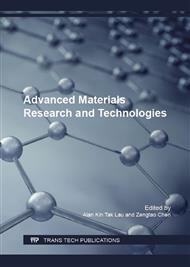p.74
p.79
p.87
p.92
p.98
p.104
p.109
p.114
p.122
Reduction of Adhesive Joining Defect in Optical Transceiver Assembly Process
Abstract:
An optical Transceiver is a device that is used for transmitting and receiving digital data which is modulated into the light source, and also consisted of two main parts as lens (one for transmitter (Tx) and another one for receiver (Rx)) and flexible printed circuit board (FPCB). The surfaces of the FPCB was manually cleaned by Isopropyl alcohol (IPA) using cotton buds, and then were joined to the lens using the glues of the adhesive Urethane Acrylate (UAA) which cured using UV light, and followed by the adhesive Black Epoxy (BEA), respectively. The joined specimen then was cured in a thermal oven. The work-piece, especially the joined between lens and FPCB was inspected by optical appearances and shear force test. The nonconformance (NC) of work-piece that is the lower specification of shear force and turbidity of the cured UAA was found about 35% of the production. The aim of this research was to reduce the joining defect of the lens and FPCB in the optical Transceiver assembly process. The applied condition and obtained output of each workstation started from backward of the process was characterized applying the Scanning Electron Microscope (SEM), the quality tools and statistical analysis in order to find root causes of the problem and to improve the process. The study found that (1) the lower shear force was related to the higher turbidity of cured UAA which normally was transparences after thermal curing; (2) the turbidity of cured UAA was resulted by repeated rubbing of using one cotton bud of worker during cleaning the FPCB surface that causes the surface contaminated and then lower adhesive force of the joint; (3) a single trip of rubbing per cotton-bud was applied and could remarkably decrease the adhesive joining defect (NC) of work-piece to 7% of the production.
Info:
Periodical:
Pages:
98-103
Citation:
Online since:
November 2016
Authors:
Price:
Сopyright:
© 2017 Trans Tech Publications Ltd. All Rights Reserved
Share:
Citation:


